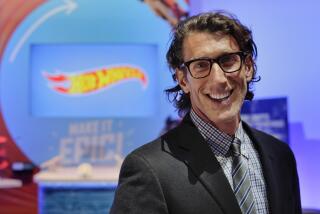Drexler to Step Down at Gap
- Share via
Millard “Mickey” Drexler, the legendary merchant who built Gap Inc. from a single shop into the nation’s largest chain of specialty clothing stores, said Tuesday that he will step down as chief executive of the struggling company.
Drexler, 57, will leave the San Francisco-based company as soon as a replacement as president and CEO is found, Gap Chairman Donald Fisher announced after the board’s quarterly meeting.
For the record:
12:00 a.m. May 23, 2002 For The Record
Los Angeles Times Thursday May 23, 2002 Home Edition Main News Part A Page 2 National Desk 8 inches; 286 words Type of Material: Correction
Gap stores--A story in Wednesday’s Business section misstated the number of Gap stores when Millard Drexler joined in 1983. There were 550.
*
Analysts praised Drexler. “He’s really what made the company what it is,” said Elizabeth Pierce, an analyst with Wedbush Morgan Securities. “I was as shell-shocked by the announcement as the next person.”
Drexler was hired by the Fisher family to run Gap in 1983, helping to build the company into an empire of more than 4,200 stores operating as Gap, Old Navy and Banana Republic. Once an icon of the casual crowd, Gap recently has been struggling after what analysts say was too much expansion and an attempt to woo a younger, trendier shopper.
More than two years of declining sales have led to the company losing more than half its stock value. To reverse flagging sales, the firm had begun to refocus on basic apparel, including basic jeans, khakis, white shirts and classic T-shirts that once held Gap in good stead.
Analysts describe Drexler, who had been with the company 19 years, as a “brilliant merchant” who was tripped up by an attempt to make Gap apparel more fashionable, an ill-fated strategy that forced the company to compete with a growing number of retailers now targeting the teen market.
And as Gap steered off course, discounters such as Target and Wal-Mart became more skilled at offering basic apparel at lower prices.
In a statement released Tuesday, Drexler said the “time is right” for him to move on and for Gap to hire a new leader.
“I’ve always loved being close to merchandise, customers and the creative parts of our business,” he said. “In a company the size of ours, the broader demands of being CEO have pulled me away from the things I’m most passionate about.”
Neither Drexler nor other company executives would comment further.
Drexler became CEO in 1995 and one of the nation’s highest- paid executives, earning more than $41.9 million in salary, bonuses and options from 1998 to 2000. According to filings, on March 15 he owned 3% of the company, worth $420 million at Monday’s closing.
Gap shares fell 33 cents to $16 on the New York Stock Exchange. The shares fell further in after-hours trading when the retirement was announced.
Retail experts, meanwhile, scrambled to analyze what the departure means for a company that some think has lost its identity.
“[Drexler] has been trying to get out of neutral for a couple of years now,” said Candace Corlett, a partner with WSL Strategic Retail, a retail consulting firm in New York.
It is not clear whether Gap will manage to win back the customers it has lost, including many baby boomers who had helped build the brand. Customers who wanted more classic looks seemed to disapprove of Gap’s investment in trendy offerings such as hip-huggers.
In a bow to older customers and those with less-than-ideal bodies, executives said in a recent conference call that the fit of its pants now will be more “democratic,” and pants will have more stretch.
“We’ve certainly turned off a number of our customers in the last couple of years when they couldn’t find what they wanted to find,” Drexler said during a conference call Thursday.
Gap is one of a number of retailers that have felt the wrath of older customers after going too far to lure young customers. Others that have gone astray and then hastily regrouped--with varying success--include Talbots, Ann Taylor and Nordstrom.
“It’s pretty unfortunate that a chain has to reach the financial desperation the Gap is in for it to wake up and realize there’s a huge audience with more discretionary income than people in their teens and 20s and 30s, and it’s the baby boomer audience,” Corlett said.
Gap’s stock has lost 53% of its value over the last year, although it is up 15% for the year.
Drexler won praise Tuesday for his overall performance at Gap.
“He’s really the vision behind creating the great basics they were known for,” analyst Pierce said.
“He was an absolutely gifted motivator,” Corlett said. “His philosophy was, ‘It can always be better.’ When the Gap was at its peak, he still knew it could be better.”
In one move to right itself, Gap last month launched a new set of television commercials, including one directed by the Coen brothers and featuring Dennis Hopper and Christina Ricci. The 30-second films are running this month during a string of popular programs.
Gap also has trimmed its expansion plans to 170 to 190 store openings this year, from an earlier goal of as many as 280 new stores.
Company executives acknowledged to analysts last week that their results had not yet caught up with their efforts to improve.
In the quarter ended May 2, earnings dropped 68% while sales dropped 9% to $2.9 billion. Sales at stores open at least a year--a key industry indicator--were down 17% for the quarter.
Last year, the company lost $8million, or a penny a share, including special charges of $204 million. Drexler has called 2001 the company’s “most difficult year ever.”
More to Read
Inside the business of entertainment
The Wide Shot brings you news, analysis and insights on everything from streaming wars to production — and what it all means for the future.
You may occasionally receive promotional content from the Los Angeles Times.










